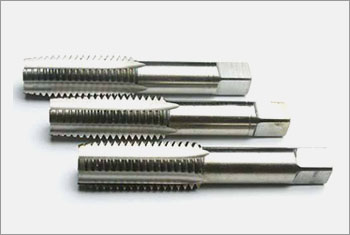Self Tapping Inserts
Product Overview
Self tapping Threaded Inserts are cylindrical metal bushing with internal and external threads and are specially designed to cut their own threads as they are being driven into a drilled hole.
Product Features

1. Hand Taps
The most commonly used wire insert taps are parallel-fluted hand taps. As they were only suitable for hand tapping earlier, they are called 'hand tap.' However, as the technology progressed, the modern hand taps that we manufacture are also suitable for machine tapping. Thanks to the improved manufacturing techniques. They are available in three different styles. We can use them individually or in combinations dependent upon application.

i) Roughing Tap
They provide a pre-prepared tapped hole before finish or bottom tapping. This ensures greater life of the second tap. They are beneficial for coarse pitch threads or rigid materials.
ii) Finishing Tap
It provides an entire diameter thread and has 3.5 taper leads-finishing taps. It is the most commonly used tap and is generally used in a single operation.
iii) Bottoming Tap
It provides an entire diameter thread to the bottom of blind holes since the tap has only 1.5 lead threads. Bottoming tap is usually used in conjunction with roughing tap.
2. Machine Taps
Machine Taps are High Speed Steel Hand Taps with straight flutes are designed for general purpose hand tapping or in production machines where ground thread accuracy and performance are required. They are suitable for tapping most materials in through or blind holes.
Machine taps are basically single cut taps and cut the thread in one work process. Since the drill is aligned vertically to the workpiece in the machine, it simplifies the cutting of a straight thread. They are available in different styles.

i) Spiral Point Taps
These have been designed primarily for the machine tapping through holes. A spiral point is ground into the lead threads at an angle to the tap axis. This produces a tap with initial left-hand flutes having a progressive cutting rake towards the point of the tap.
ii) Spiral Flute Taps
They have helical flutes ground in the same direction as the thread. This feature directs the swarf back out of the hole and makes this design appropriate for machining blind holes, particularly in materials that produce a continuous chip.
3. Cold Forming Taps
They do not have cutting edges or flutes. They are designed to cold form wire insert internal threads in aluminum, brass, magnesium, zinc, and other ductile metals. Because they do not have flutes, they are much stronger than conventional thread cutting taps and, where used correctly, result in greater tap life. Cold forming taps are not recommended where the wall thickness is less than 70% of the nominal tap diameter.

